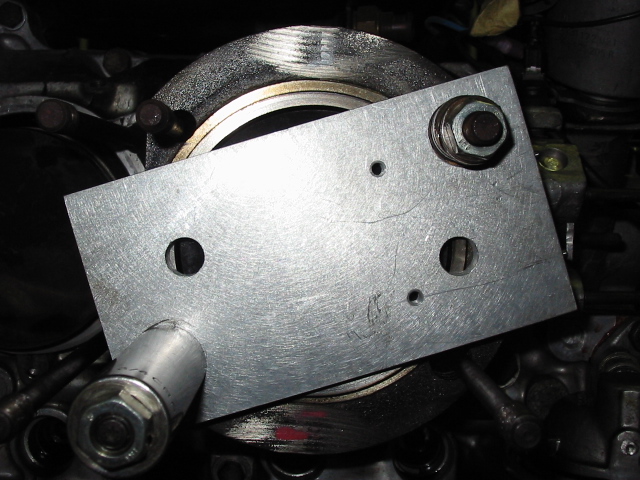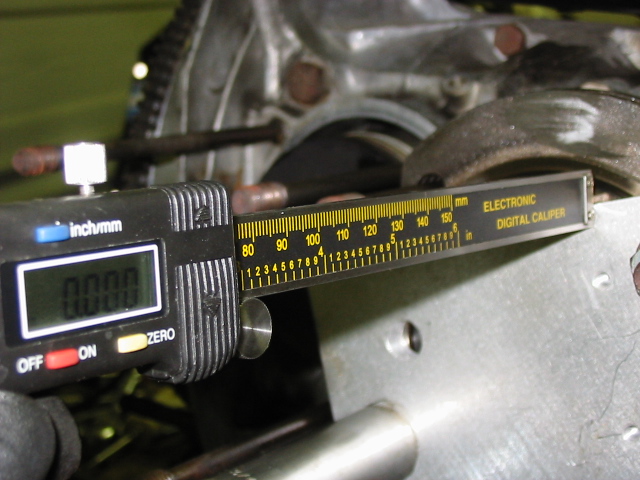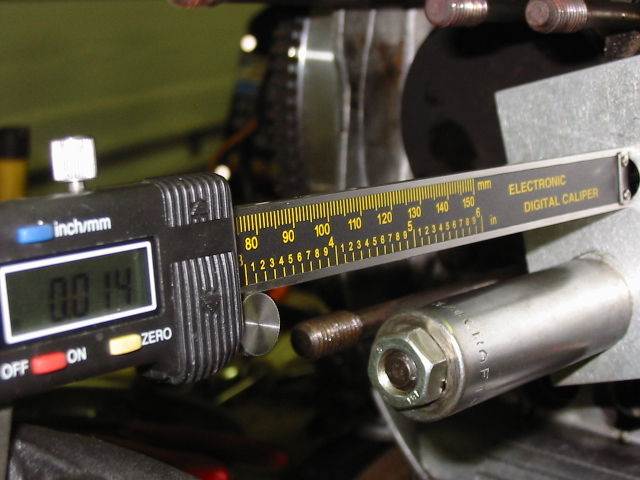|
|

|
Porsche, and the Porsche crest are registered trademarks of Dr. Ing. h.c. F. Porsche AG.
This site is not affiliated with Porsche in any way. Its only purpose is to provide an online forum for car enthusiasts. All other trademarks are property of their respective owners. |
|
|
| Jakeodoule |
 Sep 18 2009, 11:06 PM Sep 18 2009, 11:06 PM
Post
#1
|
|
Member   Group: Members Posts: 353 Joined: 10-October 08 From: Des Moines Iowa Member No.: 9,630 Region Association: Pacific Northwest |
After reading lots of post on measuring deck height, as well as searching the internet on ways to measure it. I thought there has to be an easier way…
I made a plate that fits on the cylinder. Make sure it’s a good thick plate. I then drilled holes right above the outer part of the bore on both sides. Bolt it down tight.  Then I just zeroed out the digital caliper on the upper ring of the cylinder. I checked zero on each side of the plate to make sure its flat.  Moved it to one of the piston holes that I drilled. Pushed the caliper end into the bore and turned the cylinder through…. Then I took a reading off the caliper. It only pushes the caliper in to the point of your deck height.  You have to keep the caliper straight! But I took 4 or 5 readings on each side of the piston and each time I came within .0005 of the last reading. This seems rather simple to me as you do not need to find TDC. Just turn the crank till the piston rises and falls a little bit. In between you just shove the end of the caliper in and let the piston push the caliper shaft up till the piston drops back down and that’s your deck height… I also saw many posts that said you only had to measure 1 cylinder. Thats bogus because 1 one my cylinders was .009 thou off from the others. I would measure each one if I were you. Also if you don't have any rings in you need to be careful about the piston being tilted a bit. So I just averaged the readings from side to side. I’m sure I’ve done something that I will be flamed about by all the professional motor builders, but it seems to work for me. I have thick skin so tell me what I did wrong…. |
  |
Replies
| McMark |
 Sep 20 2009, 12:35 AM Sep 20 2009, 12:35 AM
Post
#2
|
|
914 Freak!                Group: Retired Admin Posts: 20,180 Joined: 13-March 03 From: Grand Rapids, MI Member No.: 419 Region Association: None |
Cap'n, he's not talking about lapping the cylinder to the head. He's talking about making the cylinders absolutely equal, so there are no compression leaks. (IMG:style_emoticons/default/tongue.gif)
|
| ArtechnikA |
 Sep 20 2009, 07:05 AM Sep 20 2009, 07:05 AM
Post
#3
|
|
rich herzog      Group: Members Posts: 7,390 Joined: 4-April 03 From: Salted Roads, PA Member No.: 513 Region Association: None |
Cap'n, he's not talking about lapping the cylinder to the head. He's talking about making the cylinders absolutely equal, so there are no compression leaks. Yes, that's clear enough. And it must be done to an amount exactly equal to the other cylinder on that side, and absolutely parallel to the case deck and head sealing plane - and the other cylinder. I believe it can be done by a patient, trained craftsman with a big surface plate. The more you try to take off the harder it is to stay absolutely square. .009 is a bunch to try to do by hand on a steel cylinder - and if the 'off' one is .009 short, you're doing that to the other three and they all have to be square and true. It's a judgment call. If you don't have the big surface plate, the fine abrasives, and the gauges to verify that your work is absolutely true, square, and to the required dimension, nor the time it takes or patience to work slow and check often, you're probably better off having the work done by a machinist with the right tools for the job. (I am not a machinist so I don't know of that'd be a lathe, a mill, or something else...) If you have access to a machinist you can trust. Those of you who think it's easy to remove exactly .009" all across a big steel cylinder, square to the bore and parallel to the lower sealing cylinder, using the tools you've got - give it a try. It's hard. Mr Mcafee -- I believe you can do it. I actually believe JL (Cap'n Krusty) could do it if he had to. But I do not believe it should be touted as the technique of choice for the twice-a-lifetime DIY engine builder... |
Posts in this topic
 Jakeodoule an easier way to measure deck height? Sep 18 2009, 11:06 PM
Jakeodoule an easier way to measure deck height? Sep 18 2009, 11:06 PM
 McMark Look like mine, though I use a dial indicator.
Ni... Sep 18 2009, 11:18 PM
McMark Look like mine, though I use a dial indicator.
Ni... Sep 18 2009, 11:18 PM
 Todd Enlund Nice! The only thing I have to add is that it... Sep 19 2009, 01:37 AM
Todd Enlund Nice! The only thing I have to add is that it... Sep 19 2009, 01:37 AM

 Drums66
Nice! The only thing I have to add is that i... Sep 19 2009, 02:08 PM
Drums66
Nice! The only thing I have to add is that i... Sep 19 2009, 02:08 PM
 ArtechnikA
I also saw many posts that said you only had to m... Sep 19 2009, 06:47 AM
ArtechnikA
I also saw many posts that said you only had to m... Sep 19 2009, 06:47 AM
 DNHunt That's great, but, I think you need to find TD... Sep 19 2009, 06:48 AM
DNHunt That's great, but, I think you need to find TD... Sep 19 2009, 06:48 AM
 Vacca Rabite Eh, why go through all the trouble with a caliper ... Sep 19 2009, 11:05 AM
Vacca Rabite Eh, why go through all the trouble with a caliper ... Sep 19 2009, 11:05 AM
 ME733
After reading lots of post on measuring deck heig... Sep 19 2009, 12:00 PM
ME733
After reading lots of post on measuring deck heig... Sep 19 2009, 12:00 PM

 Cap'n Krusty
After reading lots of post on measuring deck hei... Sep 19 2009, 02:33 PM
Cap'n Krusty
After reading lots of post on measuring deck hei... Sep 19 2009, 02:33 PM
 ME733 :popcorn: Well capt. crusty I have noted on severa... Sep 19 2009, 05:31 PM
ME733 :popcorn: Well capt. crusty I have noted on severa... Sep 19 2009, 05:31 PM
 ME733 :popcorn: Yes , well , If the cylinder was ... .00... Sep 20 2009, 09:49 AM
ME733 :popcorn: Yes , well , If the cylinder was ... .00... Sep 20 2009, 09:49 AM
 ArtechnikA
...THIS IS WHY it is important to measure the O.A... Sep 20 2009, 10:06 AM
ArtechnikA
...THIS IS WHY it is important to measure the O.A... Sep 20 2009, 10:06 AM  |
1 User(s) are reading this topic (1 Guests and 0 Anonymous Users)
0 Members:

|
Lo-Fi Version | Time is now: 1st July 2025 - 09:42 AM |
Invision Power Board
v9.1.4 © 2025 IPS, Inc.








